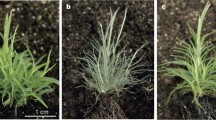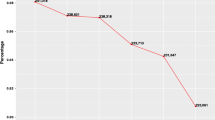Abstract
The crown and rhizome transcriptome of an upland tetraploid switchgrass cultivar cv Summer well adapted to the upper Midwest was investigated using the Roche 454-FLX pyrosequencing platform. Overall, approximately one million reads consisting of 216 million bases were assembled into 27,687 contigs and 43,094 singletons. Analyses of these sequences revealed minor contamination with non-plant sequences (< 0.5%), indicating that a majority were for transcripts coded by the switchgrass genome. Blast2Gos comparisons resulted in the annotation of ~65% of the contig sequences and ~40% of the singleton sequences. Contig sequences were mostly homologous to other plant sequences, dominated by matches to Sorghum bicolor genome. Singleton sequences, while displaying significant matches to S. bicolor, also contained sequences matching non-plant species. Comparisons of the 454 dataset to existing EST collections resulted in the identification of 30,177 new sequences. These new sequences coded for a number of different proteins and a selective analysis of two categories, namely, peroxidases and transcription factors, resulted in the identification of specific peroxidases and a number of low-abundance transcription factors expected to be involved in chromatin remodeling. KEGG maps for glycolysis and sugar metabolism showed high levels of transcript coding for enzymes involved in primary metabolism. The assembly provided significant insights into the status of these tissues and broadly indicated that there was active metabolism taking place in the crown and rhizomes at post-anthesis, the seed maturation stage of plant development.








Similar content being viewed by others
References
McLaughlin SB, Kszos LA (2005) Development of switchgrass (Panicum virgatum) as a bioenergy feedstock in the United States. Biomass Bioenergy 28(6):515–535
Schmer MR, Vogel KP, Mitchell RB, Perrin RK (2008) Net energy of cellulosic ethanol from switchgrass. Proc Natl Acad Sci U S A 105(2):464–469
Perlack RD, Wright LL, Turhollow A, Graham RL, Stokes BJ, Erbach DC (2005) Biomass as feedstock for a bioenergy and bioproducts industry: the technical feasibility of a billion-ton annual supply. Oak Ridge National Laboratory, Oak Ridge
Pedersen JF, Funnell DL, Vogel KP (2005) Impact of reduced lignin on plant fitness. Crop Sci 45:812–819
Casler MD, Buxton DR, Vogel KP (2002) Genetic modification of lignin concentration affects fitness of perennial herbaceous plants. Theor Appl Genet 104(1: 1):127–131
Vogel KP, Hopkins AA, Moore KJ, Johnson KD, Carlson IT (2002) Winter survival in switchgrass populations bred for high IVDMD. Crop Sci 42(6):1857–1862
Okada M, Lanzatella C, Saha MC, Bouton J, Wu R, Tobias CM (2010) Complete switchgrass genetic maps reveal subgenome collinearity, preferential pairing and multilocus interactions. Genetics 185(3):745–760. doi:10.1534/genetics.110.113910
Gedye K, Gonzalez-Hernandez J, Ban Y, Ge X, Thimmapuram J, Sun F et al (2010) Investigation of the transcriptome of prairie cord grass, a new cellulosic biomass crop. Plant Gen 3(2):69–80. doi:10.3835/plantgenome2010.06.0012
Huang SW, Guo SG, Zheng Y, Joung JG, Liu SQ, Zhang ZH et al (2010) Transcriptome sequencing and comparative analysis of cucumber flowers with different sex types. BMC Genomics 11. doi:10.1186/1471-2164-11-384
Luo HM, Li Y, Sun C, Wu QO, Song JY, Sun YZ et al (2010) Comparison of 454-ESTs from Huperzia serrata and Phlegmariurus carinatus reveals putative genes involved in lycopodium alkaloid biosynthesis and developmental regulation. BMC Plant Biol 10. doi:10.1186/1471-2229-10-209
Srivastava AC, Palanichelvam K, Ma J, Steele J, Blancaflor EB, Tang Y (2010) Collection and analysis of expressed sequence tags derived from laser capture microdissected switchgrass (Panicum virgatum L. Alamo) vascular tissues. Bioenergy Res 3(3):278–294
Tranel PJ, Riggins CW, Peng YH, Stewart CN (2010) Characterization of de novo transcriptome for waterhemp (Amaranthus tuberculatus) using GS-FLX 454 pyrosequencing and its application for studies of herbicide target-site genes. Pest Manag Sci 66(10):1042–1052. doi:10.1002/ps.2006
Der JP, Barker MS, Wickett NJ, dePamphilis CW, Wolf PG (2011) De novo characterization of the gametophyte transcriptome in bracken fern. Pteridium aquilinum. BMC Genomics 12. doi:10.1186/1471-2164-12-99
Swarbreck SM, Lindquist EA, Ackerly DD, Andersen GL (2011) Analysis of leaf and root transcriptomes of soil-grown Avena barbata plants. Plant Cell Physiol 52(2):317–332. doi:10.1093/pcp/pcq188
Tobias CM, Twigg P, Hayden DM, Vogel KP, Mitchell RM, Lazo GR et al (2005) Analysis of expressed sequence tags and the identification of associated short tandem repeats in switchgrass. Theor Appl Genet 111(5):956–964. doi:10.1007/s00122-005-0030-3
Tobias CM, Sarath G, Twigg P, Lindquist E, Pangilinan J, Penning BW et al (2008) Comparative genomics in switchgrass using 61 585 high-quality expressed sequence tags. Plant Genome 1(2):111–124
Vogel KP (2004) Switchgrass. In: Moser LE, Sollenberger L, Burson B (eds) Warm-season (C4) grasses. ASA-CSSA-SSSA Monograph No. 45. ASA-CSSA-SSSA, Madison, pp 561–588
Martinez-Reyna JM, Vogel KP (2008) Heterosis in switchgrass: spaced plants. Crop Sci 48(4):1312–1320. doi:10.2135/cropsci2007.12.0695
Vogel KP, Mitchell KB (2008) Heterosis in switchgrass: biomass yield in swards. Crop Sci 48(6):2159–2164. doi:10.2135/cropsci2008.02.0117
Casler MD, Vogel KP, Taliaferro CM, Ehlke NJ, Berdahl JD, Brummer EC et al (2007) Latitudinal and longitudinal adaptation of switchgrass populations. Crop Sci 47(6):2249–2260. doi:10.2135/cropsci2006.12.0780
Altschul SF, Gish W, Miller W, Myers EW, Lipman DJ (1990) Basic local alignment search tool. J Mol Biol 215(3):403–410. doi:10.1006/jmbi.1990.9999
Paterson AH, Bowers JE et al (2009) The Sorghum bicolor genome and the diversification of grasses. Nature 457(7229):551–556. doi:10.1038/Nature07723
Vogel JP, Garvin DF et al (2010) Genome sequencing and analysis of the model grass Brachypodium distachyon. Nature 463(7282):763–768. doi:10.1038/Nature08747
Passardi F, Longet D, Penel C, Dunand C (2004) The class III peroxidase multigenic family in rice and its evolution in land plants. Phytochemistry 65(13):1879–1893
Vogel KP, Sarath G, Saathoff AJ, Mitchell RB (2010) Switchgrass. Energy crops. Royal Society of Chemistry, London. doi:10.1039/9781849732048-00275
Moore KJ, Moser LE, Vogel KP, Waller SS, Johnson BE, Pedersen JF (1991) Describing and quantifying growth stages of perennial forage grasses. Agron J 83(6):1073–1077
Jain M, Garg R, Patel RK, Tyagi AK (2011) De novo assembly of chickpea transcriptome using short reads for gene discovery and marker identification. DNA Res 18(1):53–63. doi:10.1093/dnares/dsq028
Logacheva MD, Kasianov AS, Vinogradov DV, Samigullin TH, Gelfand MS, Makeev VJ et al (2011) De novo sequencing and characterization of floral transcriptome in two species of buckwheat (Fagopyrum). BMC Genomics 12:30. doi:10.1186/1471-2164-12-30
Delannoy E, Jalloul A, Assigbetse K, Marmey P, Geiger JP, Lherminier J et al (2003) Activity of class III peroxidases in the defense of cotton to bacterial blight. Mol Plant Microbe Interact 16(11):1030–1038. doi:10.1094/MPMI.2003.16.11.1030
Jeong JH, Song HR, Ko JH, Jeong YM, Kwon YE, Seol JH et al (2009) Repression of FLOWERING LOCUS T chromatin by functionally redundant histone H3 lysine 4 demethylases in Arabidopsis. PLoS One 4(11):e8033. doi:10.1371/journal.pone.0008033
Lu F, Cui X, Zhang S, Jenuwein T, Cao X (2011) Arabidopsis REF6 is a histone H3 lysine 27 demethylase. Nat Genet 43(7):715–719. doi:10.1038/ng.854
Sarnowski TJ, Rios G, Jasik J, Swiezewski S, Kaczanowski S, Li Y et al (2005) SWI3 subunits of putative SWI/SNF chromatin-remodeling complexes play distinct roles during Arabidopsis development. Plant Cell 17(9):2454–2472. doi:10.1105/tpc.105.031203
Castillejo C, Pelaz S (2008) The balance between CONSTANS and TEMPRANILLO activities determines FT expression to trigger flowering. Curr Biol 18:1338–1343
Kosugi S, Ohashi Y (2002) E2Ls, E2F-like repressors of Arabidopsis that bind to E2F sites in a monomeric form. J Biol Chem 277:16553–16558
de Jong M, Wolters-Arts M, Garcia-Martinez JL, Mariani C, Vriezen WH (2011) The Solanum lycopersicum AUXIN RESPONSE FACTOR 7 (SlARF7) mediates cross-talk between auxin and gibberellin signalling during tomato fruit set and development. J Exp Bot 62:617–626
Menand B, Yi K, Jouannic S, Hoffmann L, Ryan E et al (2007) An ancient mechanism controls the development of cells with a rooting function in land plants. Science 316:1477–1480
Gremski K, Ditta G, Yanofsky MF (2007) The HECATE genes regulate female reproductive tract development in Arabidopsis thaliana. Development 134:3593–3601
Prigge MJ, Otsuga D, Alonso JM, Ecker JR, Drews GN et al (2005) Class III homeodomain-leucine zipper gene family members have overlapping, antagonistic, and distinct roles in Arabidopsis development. Plant Cell 17:61–76
Walsh J, Waters CA, Freeling M (1998) The maize gene liguleless2 encodes a basic leucine zipper protein involved in the establishment of the leaf blade–sheath boundary. Genes Dev 12:208–218
Finkelstein R, Gampala SS, Lynch TJ, Thomas TL, Rock CD (2005) Redundant and distinct functions of the ABA response loci ABA-INSENSITIVE (ABI) 5 and ABRE-BINDING FACTOR (ABF) 3. Plant Mol Biol 59:253–267
Ehlert A, Weltmeier F, Wang X, Mayer CS, Smeekens S et al (2006) Two-hybrid protein-protein interaction analysis in Arabidopsis protoplasts: establishment of a heterodimerization map of group C and group S bZIP transcription factors. Plant J 46:890–900
Vagujfalvi A, Aprile A, Miller A, Dubcovsky J, Delugu G et al (2005) The expression of several Cbf genes at the Fr-A2 locus is linked to frost resistance in wheat. Mol Gen Genomics 274:506–514
Mu J, Tan H, Zheng Q, Fu F, Liang Y et al (2008) LEAFY COTYLEDON1 is a key regulator of fatty acid biosynthesis in Arabidopsis. Plant Physiol 148:1042–1054
Sarnowski TJ, Rios G, Jasik J, Swiezewski S, Kaczanowski S et al (2005) SWI3 subunits of putative SWI/SNF chromatin-remodeling complexes play distinct roles during Arabidopsis development. Plant Cell 17:2454–2472
Yamanouchi U, Yano M, Lin H, Ashikari M, Yamada K (2002) A rice spotted leaf gene, Spl7, encodes a heat stress transcription factor protein. Proc Natl Acad Sci U S A 99:7530–7535
Kumar R, Kushalappa K, Godt D, Pidkowich MS, Pastorelli S et al (2007) The Arabidopsis BEL1-LIKE HOMEODOMAIN proteins SAW1 and SAW2 act redundantly to regulate KNOX expression spatially in leaf margins. Plant Cell 19:2719–2735
Jeong JH, Song HR, Ko JH, Jeong YM, Kwon YE et al (2009) Repression of FLOWERING LOCUS T chromatin by functionally redundant histone H3 lysine 4 demethylases in Arabidopsis. PLoS One 4:e8033
Lu F, Cui X, Zhang S, Jenuwein T, Cao X (2011) Arabidopsis REF6 is a histone H3 lysine 27 demethylase. Nat Genet 43:715–719
Rotman N, Durbarry A, Wardle A, Yang WC, Chaboud A et al (2005) A novel class of MYB factors controls sperm-cell formation in plants. Curr Biol 15:244–248
Reyes JL, Chua NH (2007) ABA induction of miR159 controls transcript levels of two MYB factors during Arabidopsis seed germination. Plant J 49:592–606
Yoshiyama K, Conklin PA, Huefner ND, Britt AB (2009) Suppressor of gamma response 1 (SOG1) encodes a putative transcription factor governing multiple responses to DNA damage. Proc Natl Acad Sci U S A 106:12843–12848
Castaings L, Camargo A, Pocholle D, Gaudon V, Texier Y et al (2009) The nodule inception-like protein 7 modulates nitrate sensing and metabolism in Arabidopsis. Plant J 57:426–435
Asano T, Masuda D, Yasuda M, Nakashita H, Kudo T et al (2008) AtNFXL1, an Arabidopsis homologue of the human transcription factor NF-X1, functions as a negative regulator of the trichothecene phytotoxin-induced defense response. Plant J 53:450–464
Doyle MR, Bizzell CM, Keller MR, Michaels SD, Song J et al (2005) HUA2 is required for the expression of floral repressors in Arabidopsis thaliana. Plant J 41:376–385
Eulgem T, Rushton PJ, Robatzek S, Somssich IE (2000) The WRKY superfamily of plant transcription factors. Trends Plant Sci 5:199–206
Acknowledgements
We thank Steve Masterson and Patrick Callahan for excellent technical support. This work was supported by the Office of Science (BER), US Department of Energy Grant Number DE-AI02-09ER64829, and USDA-ARS CRIS project 5440-21000-028-00D. The US Department of Agriculture, Agricultural Research Service, is an equal opportunity/affirmative action employer and all agency services are available without discrimination. Mention of commercial products and organizations in this manuscript is solely to provide specific information. It does not constitute endorsement by USDA-ARS over other products and organizations not mentioned.
Author information
Authors and Affiliations
Corresponding author
Electronic supplementary material
Rights and permissions
About this article
Cite this article
Palmer, N.A., Saathoff, A.J., Kim, J. et al. Next-Generation Sequencing of Crown and Rhizome Transcriptome from an Upland, Tetraploid Switchgrass. Bioenerg. Res. 5, 649–661 (2012). https://doi.org/10.1007/s12155-011-9171-1
Published:
Issue Date:
DOI: https://doi.org/10.1007/s12155-011-9171-1




